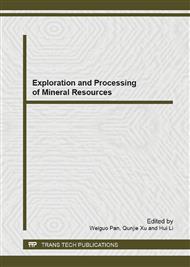[1]
N.P. Roussel, M.M. Sharma: Role of Stress Reorientation in the Success of Refracture Treatments in Tight Gas Sands [R]. Paper SPE 134491 presented at the SPE Annual Technical Conference and Exhibition held in Florence, Italy, 19–22 September (2010).
DOI: 10.2118/134491-pa
Google Scholar
[2]
E. Siebrits, J.L. Elbel, R.S. Hoover, et al: Refracture Reorientation Enhances Gas Production in Barnett Shale Tight Gas Wells [R]. Paper SPE 63030 presented at the SPE Annual Technical Conference and Exhibition held in Dallas, Texas, 1-4 October (2000).
DOI: 10.2118/63030-ms
Google Scholar
[3]
T. Lantz, D. Greene, M. Eberhard, et al: Refracture Treatments Proving Successful in Horizontal Bakken Wells; Richland Co, MT [R]. Paper SPE 108117 presented at the Rocky Mountain Oil & Gas Technology Symposium held in Denver, Colorado, USA, 16-18 April (2007).
DOI: 10.2118/108117-ms
Google Scholar
[4]
R. Jayakumar, R. Rai, A. Boulis, et al: A Systematic Study for Refracturing Modeling under Different Scenarios in Shale Reservoirs [R]. Paper SPE 165677 presented at the SPE Eastern Regional Meeting held in Pittsburgh, Pennsylvania, USA, Aug 20 - 22, (2013).
DOI: 10.2118/165677-ms
Google Scholar
[5]
Z. Rahim, D. Waspada, H. Al-Anazi, et al: Effective Analytical Approaches to Enhance Productivity of Low Producing Gas Wells [R]. Paper SPE 164614 presented at the North Africa Technical Conference & Exhibition held in InterContinental Citystar, Cairo, Egypt, Apr 15 - 17, (2013).
DOI: 10.2118/164614-ms
Google Scholar
[6]
M.C. Vincent: Refracs: Why Do They Work, and Why Do They Fail in 100 Published Field Studies?[R]. Paper SPE 134330 presented at the SPE Annual Technical Conference and Exhibition held in Florence, Italy, 19-22 September (2010).
DOI: 10.2118/134330-ms
Google Scholar
[7]
M.K. Fisher, J.R. Heinze, C.D. Harris, et al: Optimizing Horizontal Completion Techniques in the Barnett Shale Using Microseismic Fracture Mapping[R]. Paper SPE 90051 presented at the SPE Annual Technical Conference and Exhibition held in Houston, Texas, 26-29 September (2004).
DOI: 10.2118/90051-ms
Google Scholar
[8]
A.A. Ketter, J.L. Daniels, J.R. Heinze, et al: A Field Study Optimizing Completion Strategies for Fracture Initiation in Barnett Shale Horizontal Wells[R]. Paper SPE 103232 presented at the SPE Annual Technical Conference and Exhibition held in San Antonio, Texas, USA, 24-27 September (2006).
DOI: 10.2118/103232-ms
Google Scholar
[9]
N.P. Roussel, M.M. Sharma: Selecting Candidate Wells for Refracturing Using Production Data[R]. Paper SPE 146103 presented at the SPE Production & Operations, February (2013).
DOI: 10.2118/146103-pa
Google Scholar
[10]
P.C. Li, Z.Y. Song, and Z.Z. Wu: Discussion on the Relationship of Refracture Reorientation and Geostress Reorientation[R]. Paper presented at the 4thNational Conference on Deep Rock mechanics, CSRME, Beijing, Dec. 17-18 (2005).
Google Scholar
[11]
P.C. Li: Study on Fracture Initiation Mechanism for Refracturing Treatments in Ordos Basin [R]. Postdoctoral Research Report, China University of Petroleum and Changqing Petroleum Exploration Bureau, Xi'an (2006).
Google Scholar
[12]
P.C. Li, Z.Y. Song, and Z.Z. Wu: Study on Reorientation Mechanism of Refracturing in Ordos Basin - A Case Study: Chang 6 Formation, Yanchang Group, Triassic System in Wangyao Section of Ansai Oilfield[R]. Paper SPE 104260 presented at the International Oil & Gas Conference and Exhibition held in China, 5-7 December (2006).
DOI: 10.2118/104260-ms
Google Scholar
[13]
C.A. Wright, D.W. Stewart, M.A. Emanuele, et al: Reorientation of Propped Refracture Treatments in the Lost Hills Field[R]. Paper SPE 27896 presented at the Western Regional Meeting held in Long Beach, California , 23-25 March (1994).
DOI: 10.2118/27896-ms
Google Scholar
[14]
Z.Y. Wei, X.L. Zhang, B.K. Wang, et al: Impact of Stress Changes on Repeated Fracturing [R]. DRILLING & PRODUCTION TECHNOLOGY, 37-39(2008).
Google Scholar
[15]
Y. Deng: Study on Mechanical Mechanism of New Fracture Induced by Re-fracturing [D]. Southwest Petroleum University (2005). (In Chinese).
Google Scholar
[16]
H.W. Liu: Concise Mechanics of Materials, Second Edition [M]. Higher Education Press (2008). (In Chinese).
Google Scholar
[17]
A. Taghichian: On the Geomechanical 0ptimization of Hydraulic Fracturing in Unconventional Shales [D]. Doctoral Dissertation, University of Oklahoma (2013).
Google Scholar
[18]
Z.L. Xu: Mechanics of Elasticity, Fourth Edition [M] . Higher Education Press (2006). (In Chinese).
Google Scholar
[19]
S.Y. Wang, X.L. Luo, R.S. Hurt: What We Learned from a Study of Re-fracturing in Barnett Shale: An Investigation of Completion/Fracturing, and Production of Re-fractured Wells[R]. Paper SPE 17081 presented at the 6th International Petroleum Technology Conference held in Beijing, China, Mar 26 – 28 (2013).
DOI: 10.2523/17081-abstract
Google Scholar


